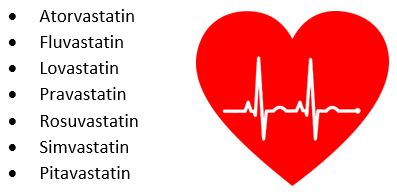Atherosclerotic cardiovascular disease (ASCVD), including coronary heart disease (CHD), stroke, and peripheral artery disease, is one of the leading causes of death in the United States.1 Risk factors for ASCVD include high cholesterol, diabetes, smoking, and hypertension.
Cholesterol levels can be reduced by diet, exercise, and medications such as statins.2 According to the 2018 cholesterol guidelines by the American College of Cardiology (ACC) and American Heart Association (AHA), varying intensities of statin therapy are recommended as adjunct therapies to a heart-healthy lifestyle and diet for patients with ASCVD, at high-risk of developing ASCVD, and those with hypercholesterolemia for the primary prevention of ASCVD. Statins are a class of medications that lower cholesterol levels by inhibiting the hydroxymethyglutaryl-CoA reductase enzyme involved in the rate limiting step of cholesterol biosynthesis.3,4 At maximal doses, the most potent statins can reduce low-density lipoprotein cholesterol (LDL-C) by 55% to 60% on average.5
The ACC/AHA 2018 cholesterol guidelines2 recommend varying intensities of statin therapy for:
- Patients with clinical ASCVD
- Patients with severe primary hypercholesterolemia (LDL-C level ≥190 mg/dL)
- Patients 40 to 75 years of age with diabetes mellitus and LDL-C levels ≥70 mg/dL to 189 mg/dL
- Patients 40 to 75 years of age without diabetes mellitus and LDL-C levels ≥70 mg/dL to 189 mg/dL and 10-year ASCVD risk of ≥7.5%, if a discussion of treatment options favors statin therapy
- Risk-enhancing factors may favor statin therapy in patients at 10-year risk of 5% to 7.5% (borderline risk)”
Risk-enhancing factors should be taken into account in the discussion of treatment options. These include the following:2
- family history of premature ASCVD
- persistently elevated LDL-C levels ≥160 mg/dL (≥4.1 mmol/L)
- metabolic syndrome
- chronic kidney disease
- history of preeclampsia
- premature menopause (age <40 years)
- chronic inflammatory disorders (e.g., rheumatoid arthritis, psoriasis, or chronic HIV)
- high-risk ethnic groups (e.g., South Asian)
- persistent elevations of triglycerides ≥175 mg/dL (≥1.97 mmol/L)
- if measured in selected individuals:
- apolipoprotein B ≥130 mg/dL
- high-sensitivity C-reactive protein ≥2.0 mg/L
- ankle-brachial index (ABI) <0.9 and lipoprotein (a) ≥50 mg/dL or 125 nmol/L, especially at higher values of lipoprotein
According to manufacturers, statins are indicated as adjunct therapies to diet in:
- Patients without CHD to reduce the risk of myocardial infarction (MI), stroke, revascularization procedures, and angina6-10
- Patients with type 2 diabetes and multiple risk factors, but without CHD, to reduce the risk of MI and stroke10
- Patients with slow progression of atherosclerosis as part of a treatment strategy to lower total cholesterol (total-C) and LDL-C6,10
- Patients with CHD to reduce the risk of non-fatal MI, stroke, revascularization procedures, hospitalization for chronic heart failure, and angina8-10
- Patients with primary hyperlipidemia (heterozygous familial and nonfamilial) and mixed dyslipidemia8 to reduce elevated total-C, LDL-C, apo B, and triglyceride (TG) levels and increase high-density lipoprotein cholesterol levels6,7,9-11
- Patients with hypertriglyceridemia and primary dysbetalipoproteinemia to reduce elevated TG levels6-8
- Patients with homozygous familial hypercholesterolemia to reduce total-C and LDL-C levels6,7,10
- Children and adolescent patients with heterozygous familial hypercholesterolemia after failing diet therapy, to reduce elevated total-C, LDL-C, and apo B levels6-8,10
Statin therapy reduces the risk of heart attack and stroke by about 20% regardless of the baseline lipid level.12 This means that the higher the risk, the greater the absolute benefit. The Cholesterol Treatment Trialists’ Collaborators performed a meta-analysis13 that evaluated the effects of lowering LDL-C in patients at low risk of vascular disease. They found that statin therapy reduces the risk of ASCVD events regardless of the baseline lipid profile, and that the overall risk rather than the initial LDL-C level determined the magnitude of the benefit of statin treatment. The number needed to treat to avoid one event (NNT) over the course of ten years was 50. Thavendiranathan et al. performed a meta-analysis14 of seven primary prevention trials that included 42,848 patients, with a mean follow-up of 4.3 years. They found that statin therapy decreased the incidence of major coronary and cerebrovascular events and revascularizations, but not CHD or overall mortality. They also found that the higher the baseline risk, the greater the absolute benefit of the statin, and the lower the NNT.
References
- Kochanek KD, Murphy SL, Xu JQ, Arias E. Mortality in the United States, 2016. NCHS Data Brief, no 293. Hyattsville, MD: National Center for Health Statistics. 2017.
- Grundy SM, Stone NJ, Bailey AL, et al. 2018 AHA/ACC/AACVPR/AAPA/ABC/ACPM/ADA/AGS/APhA/ASPC/NLA/PCNA Guideline on the management of blood cholesterol: executive summary: a report of the American College of Cardiology/American Heart Association Task Force on clinical practice guidelines. J Am Coll Cardiol. 2018.
- Sirtori CR. The pharmacology of statins. Pharmacol Res. 2014;88:3-11.
- Lennernas H, Fager G. Pharmacodynamics and pharmacokinetics of the HMG-CoA reductase inhibitors. Similarities and differences. Clin Pharmacokinet. 1997;32(5):403-425.
- Newman CB, Preiss D, Tobert JA, et al. Statin safety and associated adverse events: a scientific statement from the American Heart Association. Arterioscler Thromb Vasc Biol 2019; 39 (2): e38-e81.
- Crestor [package insert]. Wilmington, DE: AstraZeneca Pharmaceuticals LP; 2010.
- Zocor [package insert]. Northumberland, UK: Merck Sharp & Dohme LTD.; 2018.
- Pravachol [package insert]. Princeton, NJ: Bristol-Myers Squibb Company; 1991.
- Altoprev [package insert]. Ft. Lauderdale, FL: Watson Laboratories; 2002.
- Lipitor [package insert]. Dublin, Ireland: Pfizer Ireland Pharmaceuticals; 2009
- Livalo [package insert]. Montgomery, AL: Kowa Pharmaceuticals American, Inc.; 2009.
- Baigent C, Blackwell L, Emberson J, et al. Efficacy and safety of more intensive lowering of LDL cholesterol: a meta-analysis of data from 170,000 participants in 26 randomised trials. Lancet 2010; 376 (9753): 1670-1681.
- Mihaylova B, Emberson J, Blackwell L, et al. The effects of lowering LDL cholesterol with statin therapy in people at low risk of vascular disease: meta-analysis of individual data from 27 randomised trials. Lancet 2012; 380 (9841): 581-590.
- Thavendiranathan P, Bagai A, Brookhart MA, Choudhry NK. Primary prevention of cardiovascular diseases with statin therapy: a meta-analysis of randomized controlled trials. Arch Intern Med 2006; 166 (21): 2307-2313.


